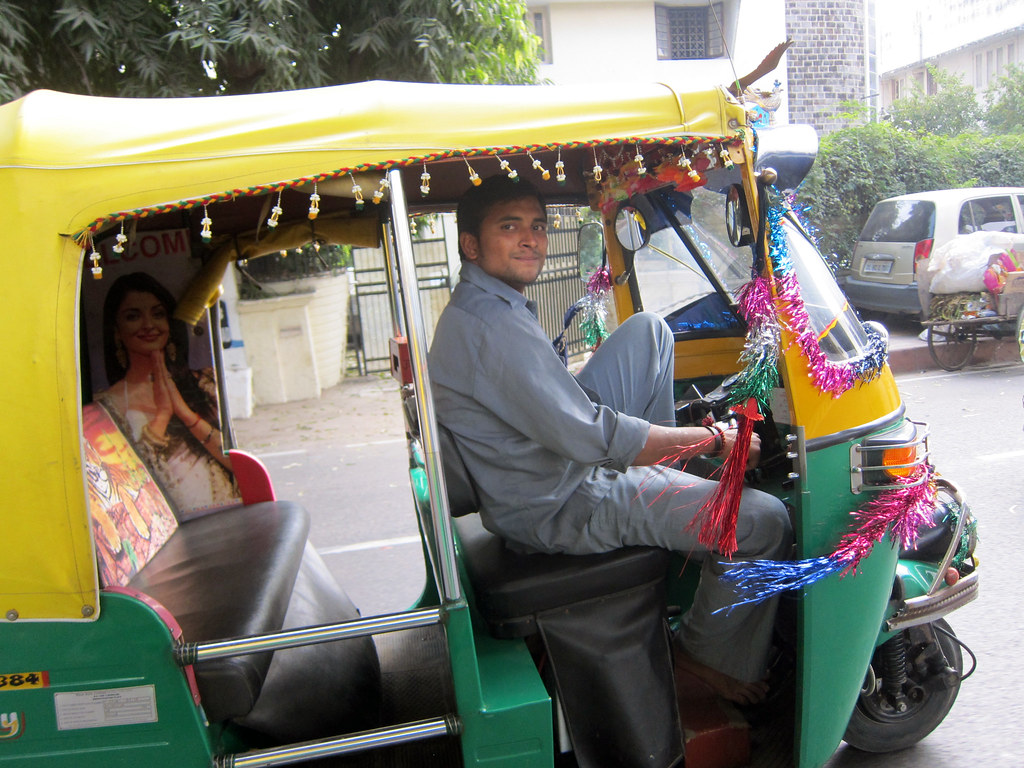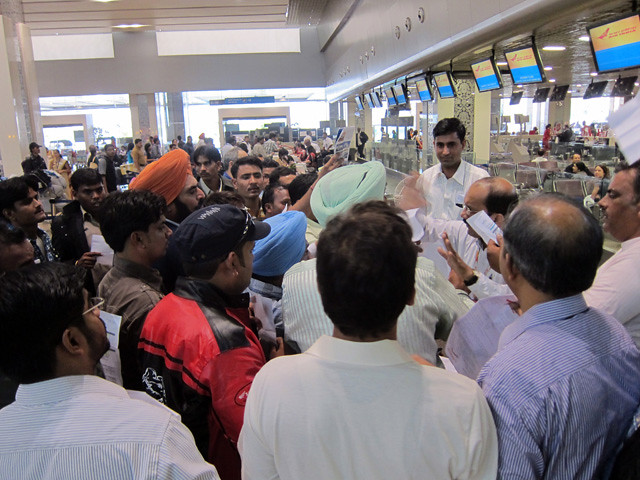Namaste!
NEW DELHI — I was flying to Delhi in the days leading up to Diwali, the biggest day in the Hindu calendar, and so direct flights from Dubai were full. The only option was to fly to Bombay and grab a connecting flight to Delhi from there. I’d played it safe and gave myself six hours between flights. What could possibly go wrong?
The Air India flight was four hours late in leaving Dubai, but no sweat, I thought. I’d planned for this, and two hours to make my connection would still be plenty. The lady back at check-in assured me my luggage would be waiting for me in Delhi, and my boarding pass would be waiting for me at the gate, so all I had to do was clear customs and find the 8:05 to Delhi and Bob would, in theory, be my uncle. The flight landed in Bombay at first light, and the passengers — all-Indian and all-male, it seemed, heading home for the holidays, plus me — piled into a bus on the tarmac and waited. While standing there on the bus, I thought about what little I knew about travel in India, most of it gleaned from Seinfeld.
httpvh://www.youtube.com/watch?v=_sUMtHcUMWo
Half an hour later we were in the international arrivals hall, which resembled what I’d expected an Indian train station to be like. The crowd shuffled past hand-painted signs in English and Hindi through a labyrinth of makeshift hallways, which were all particle-board and exposed wiring and, strangely, stank of urine. I made it through immigration, and found myself at the luggage carousels. My luggage was supposed to go straight to Delhi, but I had a funny feeling about this, and so I waited at the carousel until all the luggage had been claimed. Indians, I noted, have this endearing habit of drawing waybills on A4 sheets and taping them to their luggage, indicating their name, phone number, and address of their destination, usually with lovingly ornate, hand-drawn typography. My rubberized Swiss army surplus rucksack didn’t have a homemade waybill, nor did it appear on that luggage carousel. This was worrying. I had to know for sure where my luggage was, so I approached a half-dozen airport employees and got a half-dozen different answers. Most of them could confirm, though, that no international flights to Bombay had their luggage automatically sent on to Delhi. From the looks of it, my luggage didn’t make it, not to Bombay and not to Delhi for that matter.
There was no lost-luggage desk at that arrivals hall, so I abandoned all hope for my possessions and concentrated on getting myself on that plane to Delhi. I followed the signs reading DOMESTIC TRANSFER, and after a 20-minute queue I reached the source of the bottleneck: an impressively moustachioed man flanked by two policemen wielding WW2-era, bolt-action Lee-Enfield rifles. He wanted to see my boarding pass.
“I don’t have a boarding pass,” I said.
“You must have a boarding pass to get on the bus,” he said.
“My boarding pass is supposed to be waiting for me at the gate,” I said.
“You must have a boarding pass to get on the bus,” he said, frowning this time.
Obviously, I wasn’t getting on that domestic transfer bus. I couldn’t get an answer out of him about what my options were at this point, so I turned around and went through customs to the domestic arrivals hall, which, at 6:30 in the morning, was bedlam. I eventually found an Air India desk where a clerk was doing her nails. I really, really wanted my boarding pass. She couldn’t provide one; I’d have to get that at the domestic terminal. Why don’t I just take the transfer bus there?
“I can’t take the transfer bus without a boarding pass,” I said.
“Oh,” she said.
The domestic terminal was eight kilometres away, it turned out, and I’d have to get there by autorickshaw. To pay for that, I’d need some rupees, but all the ATMs in the arrivals hall were out of order, and all I had were some leftover UAE dirhams, so exchanging money was out of the question. I went outside and hailed one of these three-wheeled Indian taxis. I was pleased to note that Piaggio was behind their design, and the steering column shared parts with my P200 Vespa, including the left-hand clutch and manual shift.
“An ATM, please!” I said.
“Yes boss!” said the driver, and he popped it in first with that familiar ker-chunk and goosed it. We bounced and rattled through suburban Bombay on the wrong side of the road in the grey morning light, swerving to avoid potholes and running children and an astonishing amount of free-range urban cattle. Many, many other autorickshaws were out that morning, and when I first saw all these vehicles darting through Bombay’s streets, I found myself stifling a smile. It really is a pretty comical sight.
Eventually we found an ATM that worked, I took out my daily limit of rupees, and told the autorickshaw driver to gun it for the domestic terminal. I still had half an hour before my flight. Maybe, just maybe, I’d make it.
“Yes boss!” he said, and pulled back into thick, honking traffic. Half an hour later we were there. “Domestic terminal!” he announced.
The scene inside was somehow worse than back at International. Imagine JFK or Heathrow or Charles de Gaulle a few days before Christmas, then transpose that upon India, with its 1.2 billion people, and you’ll have an idea of what I’m getting at. There were no real lineups at the check-in desks, just a sea of humanity spread throughout the hall in densities ranging from elbow-to-elbow to uncomfortably familiar.
According to the big board, boarding for my flight had already closed. To get on another flight I could either go to any of several Air India check-in desks, out there among the hoi polloi, or try and find some other desk where I wouldn’t have to stand for hours waiting to talk to somebody. I went with the latter, and found an Air India customer service desk amazingly easily. The lady there tried to be understanding, but said, “Aha. For this domestic concern, you must find an India Air transfer desk. It is downstairs.”
I went downstairs, and sure enough, there existed something called India Air, which had a lot of the colour red in a very similar logo. The lady there, too, tried to be understanding, but said, “Aha. For this international concern, you must find an Air India transfer desk. It is upstairs.”
Air India, India Air, similar logos — same airline? Different airline? It didn’t matter. I realized my fate lied out there at the check-in counters, with all those people. At least I didn’t have any heavy luggage to haul around. I walked around until I started to recognize some of the passengers from the Dubai flight. There was some camaraderie amongst this marooned group, and I was relieved to know that I was at least in the right place for onward travel.
All that camaraderie instantly evaporated when a harried Air India representative appeared. The crowd, at least three dozen strong, converged on him and shoved their papers at him through the throng, making an unholy ruckus all the while. It reminded me of a crowd of devoted Catholics thrusting babies at the Pope. The hapless attendant grabbed one set of papers at random, and got behind his terminal and started trying to solve one large problem of many. I craned my neck around the crowd and got a sight of the reservation software: it was running on a yellowed, very old machine, and the representative was entering queries that looked like MS-DOS commands. A rumour began to circulate that of the 14 remaining flights to Delhi that day, all were full, and the representative was trying to get us on standby.
And then he’d go away for a while, leaving the crowd to calm down and accept its fate before he returned and the dog-eat-dog melee resumed. A few hours passed this way. I started doing the math: at the rate he was going, with 5 minutes to process each person and a 15 minute break between each, it could be another 12 hours before I’d be on my way. There was nowhere to sit, so I tried sitting on the floor, until I noticed that it was just disgusting down there and besides, people were spitting red tobacco juice everywhere. Standing it was, then. Among my group of stranded travellers, one guy spoke excellent English. He was in Bombay on business, and desperately needed to get home to Delhi, where his wife would be cooking dinner that night. I guess that’s a good as reason as any to get preferential treatment. He explained that if I wanted to get my boarding pass, I had to be more assertive.
The representative returned, the crowd swarmed, and then my new friend showed me what he meant. He shoved his way to the front of the crowd and lectured the representative, first in Hindi but then in English — perfect, crisp, cut-glass Indian English — and his volume grew. The representative took notice, and engaged him back, also in English but not quite as well. Advantage: Bombay business guy. At least he’d captured the rep’s attention, and demonstrated his superior English skills. Bombay business guy grew more animated until he was shouting and veins were popping on his forehead. The Air India representative responded in kind. Before long, their faces were inches apart and twitching as they hollered at each other. It was the most entertaining thing I’d seen in ages. Then Bombay business guy got in a devastating jab: “WHAT IS THIS… THIS…” he said, gesturing around, at himself and the jostling crowd, “THIS THIRD-WORLD BULLSHIT?!”
It was awesome. He’d struck a nerve, and the humbled Air India representative hunkered down behind his terminal and got him on another flight pronto. He was all smiles after that, with no sign of the screaming berserker I’d seen a few minutes earlier, and tried again to get me to throw my weight around. “Come on,” he said, “You’re a white guy. Half the battle is already won.” He positioned himself behind me and shoved me to the front of the crowd. My face was hot with embarrassment as I feebly waved my airticket receipt in front of the Air India guy’s face.
I didn’t even have to say anything. Within minutes, the representative was processing my new boarding pass. The next available flight left in four hours.
“Luggage?” the representative said. “It says that you have one checked bag.”
“Not anymore,” I said.
“I need your luggage,” he said.
“Your airline lost it,” I said.
I could already hear the needle being dragged off the spinning record. Maybe if I stared at him intently enough, he’d let me on the plane without my bag. I stared, intently.
There was a pause. “Ok,” he said, “just go to the desk inside and fill out a lost luggage claim.” He then handed me my new boarding pass and wished me a pleasant flight.
Somebody, somewhere, once said that the ritual of modern air travel is a lot like attending a fascist stranger’s funeral. I like this comparison. However, changing planes in Bombay is a bit different — it’s more like being a contestant on a particularly sadistic Japanese game show. In hindsight, it might have been less stressful to try and sneak across the Pakistani border on my Vespa, through some uninhabited stretch of the Baluchistan desert, and get to India overland.
•
It was around sunset when I landed in Delhi. I hopped in a taxi and headed towards my hotel, a place called West Inn, in a midtown neighbourhood called West Patel Nagar. I’d chosen the hotel for the high-end boutique features it appeared to have, its midrange prices, and also for the name — you had to admire the cheek of a business that hoped to get accidental spillover from people who wanted to go to the Westin. After an hour and a half in the taxi, we were on an unpaved, broken road in a crowded neighbourhood, and I couldn’t see much out the window for all the dust in the highbeams.
“West Inn,” the driver said, and then tried to rip me off to the tune of twice the meter rate.
“Sorry, hombre,” I said, and handed him the exact number of rupees as indicated on the meter. No tip for you. He freaked, and made threatening noises, but I just walked into the hotel. I’d had a long day and really didn’t need that.
The West Inn folks had no indication of my reservation, but that was okay, because they had a special room and rate available justforyoumyfriend. Now, it should be said that the pictures on the website didn’t lie: it really was done up in a high-end sort of boutique-y way. But that was just for the photo shoot. The place had the fit-and-finish of the Sudden Valley model home in Arrested Development, and in the very short span of its existence, things had gone seriously downhill: fake wood panelling peeled from the walls, unidentifiable discolorations were smeared across the walls, and the sheets had mysterious stains on them. The place stank, and every fixture in the bathroom, despite their chichi, stainless steel design, was either askew or falling off. I tried taking a much-needed shower, and found to my dismay that the water sprayed by the expensive-looking showerhead all over the bathroom also carried with it a good deal of electrical current. But the room had a bed, and that was comfortable, and I laid down and stared at the ceiling and thought about my day.
It wasn’t just one person who’d fucked up. This was no single, lone fuck-up cascading through the nooks and crannies of a complex system, like a butterfly causes a hurricane; everybody who touched my life that day, apart from, thankfully, the pilot and the airframe maintenance crew and my rickshaw driver, was busy fucking up in one way or another, sometimes spectacularly so. The guy who had all that time to anticipate the Diwali crush and thousands of rebookings fucked up. The guy who’d arranged the airport signs fucked up. So did the guy who cleaned the floors. The women representing Air India and India Air were a pair of fucknuts; the baggage handlers were probably already pretty fucked up before they even got to work, which of course fucked things up even worse. And the guy who designed the airport had, at some point well in the past, fucked up pretty royally. Even my taxi driver was a complete fuckup. The president of Air India? That guy’s totally fucked in the head. What was most remarkable about it, though, is that despite things being so thoroughly fucked, I did eventually get where I was going. With my western eye, all I could see was disaster, chaos, and impossibility; what I couldn’t see, until a good samaritan made it clear, is that there was in fact a solution. I’d been told that this is a common thing in India, that life there can be a series of 11th-hour miracles.
And all this, at the freakin’ airport. If there was going to be more of the same in India, I’d better get used to it — and learn to navigate it better — before I tried to ride my scooter from one end of the country to the other.















December 29th, 2010 at 7:47 pm
hi, Welcome to India. I’ve to say it was very bold of you to fly on Air India. even Indians don’t fly Air India lol, only exceptions being people who have no other choice. They work for the government, so only way to get things done is by yelling n screaming at them. have fun here
December 31st, 2010 at 11:39 am
india is a chaotic country where nothing works efficiently.so xpect all this.imagine how much an average indian has to struggle to lead a normal life n this country!!!
February 11th, 2011 at 9:52 am
hi!! Sean, sorry all about what happened with you in India. you have Seen a part of India,that is different aspect. this is growing country with 2nd largest population of the world, Mr. kareem your welcome on your view. theas comment will influence us to reach up to peak of world power.
February 13th, 2012 at 2:05 am
Good day! I just found your internet site: Namaste! | The Vespa360 Project when I was browsing delicious.com. It looks as though someone appreciated your site so much they decided to bookmark it. I’ll surely be returning here more often.
February 22nd, 2012 at 1:06 pm
xxvuuwftqb471, hmnagjuktn